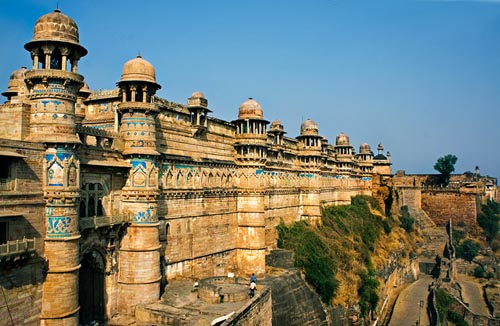Man Mandir Palace

Information on Man Mandir Palace (Gwalior, Madhya Pradesh) - History & Architecture
Man Mandir Palace is located inside the Gwalior Fort, which is placed at an elevated area of Shivapuri District of Gwalior State of Madhya Pradesh, India. This fortress consist of many fort built from the 7the century to the 15th century AD. This fort is built by Man Singh of Tomar of Tomar Dynasty. It is well known for its craftsmanship on the walls of this palace. It is one of the large lovely palaces inside the fortress of Gwalior in Madhya Pradesh. It is the best tourist spot to see Indian royal palaces.
Man Mandir Palace Architecture
Man Mandir Palace is basically built in the Hindu architectural structure. It has many Vedic patronage depicted on its stone carvings all around the edifice. This is a three storied structure built on a citadel. It is a large square type palace with a centrally open place filled with beautiful gardens and stone sculptures. The entrance wall is splendidly carved on its walls. It has beautiful floral designs, ditties of Hindu gods and goddesses. Its carving works on the walls are breathtaking. The unique feature is that there are large windows here but won't look like windows from a distance, since these are grilled with artistic work on small stone carvings which stood as a curtain or a grill like structure. This was built since the royal woman's to see outside and no one can see them from the front of the palace. On the inner part there is a special place for women's to learn art and culture related studies, which includes the famous music hall. Another disappointing place is the Sathi Kund, it is believed that, here the queens along with the royal patronage ladies self immolate them self in time s of war and crises. This take place when they came to know, they were nearing to capture or their beloved is dead in the war. This is also known as the Juhar Kund in the palace. It has a spacious court area. The Gwalior fortification walls are the biggest barrier for this palace, providing a total protection from external aggression. The construction material applied here are the granite stone, sandstone, woods and marbles. Lime stone paste is the bonding material used all over the palace.
Man Mandir Palace History
Man Mandir Palace was built by Tomoar Dynasty ruler named Man Singh Tomar in the year 1486. It took nearly three decades to complete the entire work of this palace. After the completion of this work, it looked the most beautiful palace inside the Gwalior Fort. This palace is well known for its queen Mrignayni, who fought many wars with Man Sigh and the Battle of Haldighati was the last battle for Mansingh. This place is famous for the wars with the Mughal emperor Aurangzeb and the Lodhi Dynasties. This palace is known for the great Juhar committed by its queen at the event of the Maharaja's death in the battle with Ibrahim Lodhi in the year 1516 AD.
Man Mandir Palace Tourism Importance
Man Mandir Palace is one among the significant places in the Gwalior fortified area of Shivapuri. It is open to public and well known for this craftsmanship. This is a protected monument of ancient history and maintained by the tourism and archeological department of Madhya Pradesh. Its historical importance and the amazing architectural structure invites visitors not just from India but from across the world, where them come to relish the outstanding creation of mankind of the era and even today portray the same to the present generation.
- Andaman Nicobar Monuments
- Andhra Pradesh Monuments
- Assam Monuments
- Bihar Monuments
- Chhattisgarh Monuments
- New Delhi Monuments
- Goa Monuments
- Gujarat Monuments
- Haryana Monuments
- Himachal Pradesh Monuments
- Jammu and Kashmir Monuments
- Karnataka Monuments
- Kerala Monuments
- Madhya Pradesh Monuments
- Maharashtra Monuments
- Odisha Monuments
- Punjab Monuments
- Rajasthan Monuments
- Tamil Nadu Monuments
- Telangana Monuments
- Uttar Pradesh Monuments
- West Bengal Monuments